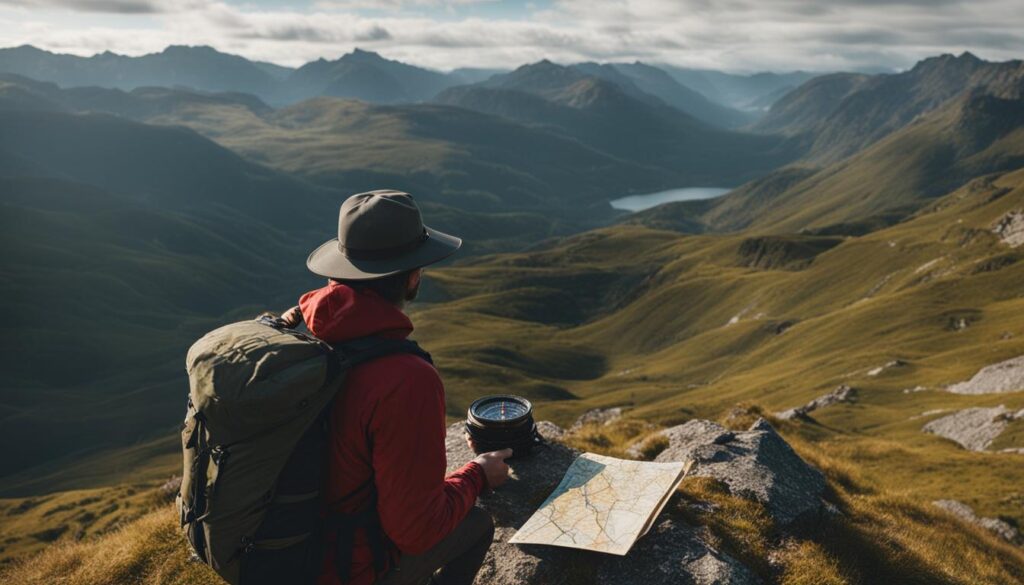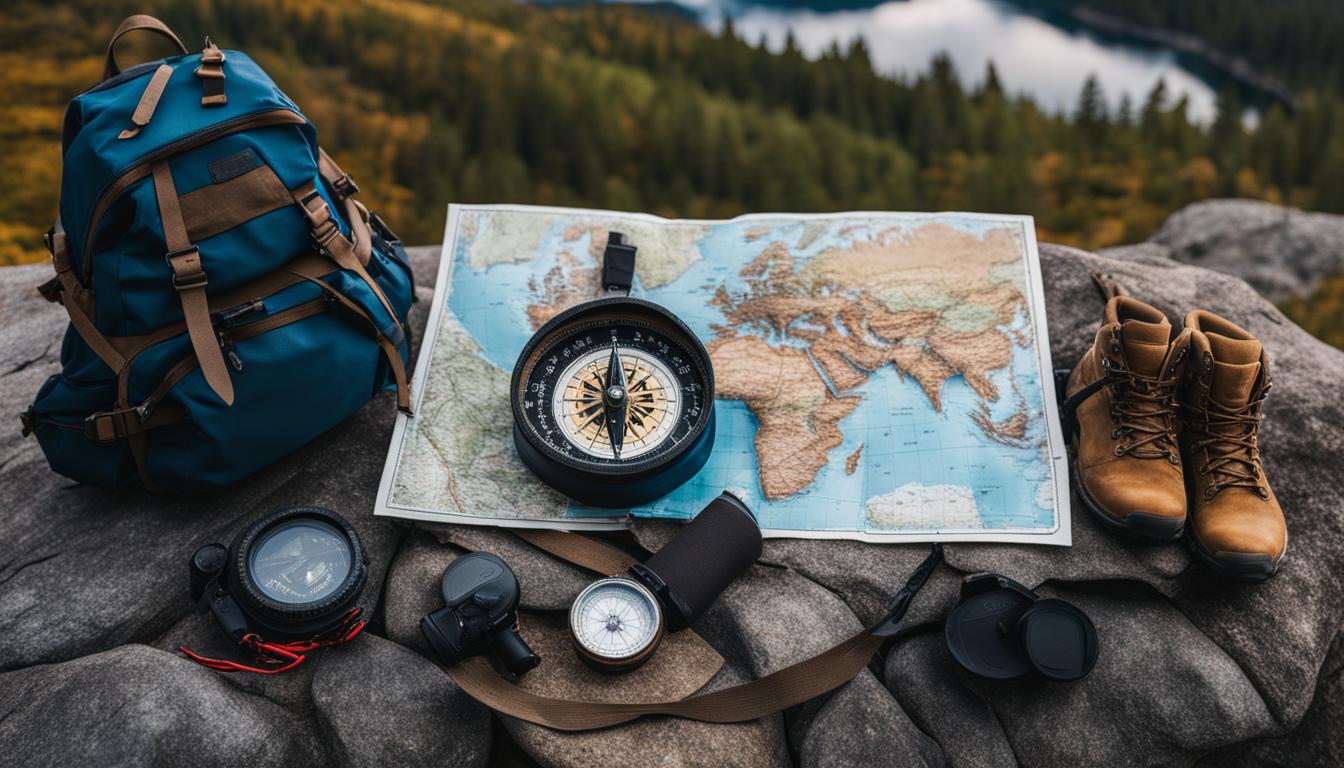Learning how to use a compass and map is essential for backpackers and hikers who want to navigate the wilderness with confidence. While GPS devices and smartphones may seem convenient, they can fail at crucial moments, leaving you lost in the backcountry. With a compass and map, you can rely on the Earth’s magnetic fields and your navigational skills to find your way. In this section, we will explore the importance of learning compass navigation and the basic components of a compass.
Key Takeaways:
- Using a compass and map is crucial for backpacking navigation skills and orienteering techniques.
- GPS devices are not always reliable in outdoor settings, making compass navigation essential.
- Get to know the different components of a compass to effectively use it for navigation.
- You can find your location and take bearings with a compass to navigate in the wilderness.
- By honing your compass skills, you can confidently explore the backcountry and ensure your safety.
Why Should I Learn to Use a Compass?

Compass navigation is an essential skill for anyone venturing into the wilderness. While GPS technology has undoubtedly made navigation more convenient, it is not infallible. GPS devices can run out of battery, lose signal, or provide inaccurate information. As an experienced backpacker, I can attest that relying solely on electronic devices for navigation can be risky. That’s why it’s crucial to learn how to use a compass.
A compass is a reliable and durable tool that can save you from getting lost and ensure your safety in the backcountry. Unlike electronics, a compass relies on the Earth’s magnetic fields, which are always present. Even in remote areas with no cell service or GPS signal, a compass will faithfully point you in the right direction. By mastering the art of compass navigation, you will gain the confidence to explore the great outdoors without being dependent on technology.
Moreover, learning how to use a compass enhances your overall navigation skills. It not only teaches you how to find your bearings but also helps you understand the landscape and interpret topographical maps effectively. With a compass in hand, you become more aware of your surroundings and develop a deeper connection with nature. So, embrace the old-school method of compass navigation and discover a whole new level of self-reliance and adventure.
As the saying goes, “Don’t leave home without it!” A compass is a timeless tool that can be a lifesaver in challenging situations. So, let’s dive into the world of compass navigation and unlock the skills that will set you apart as an experienced backpacker.
Getting to Know Your Compass
When it comes to using a compass effectively, understanding its different components is essential. A compass consists of several parts that work together to provide accurate navigation. Let’s take a closer look at each of these components:
The Baseplate:
The baseplate is the flat, rectangular part of the compass that serves as a foundation for all other components. It often features rulers and scales to help measure distances on a map.
The Direction of Travel Arrow:
This arrow, usually located in the middle of the baseplate, indicates the direction in which you are heading or planning to travel. It plays a crucial role in aligning the compass with the desired direction.
The Index Line:
The index line is a mark or line on the baseplate that aligns with the direction of travel arrow. It helps you read the bearing or course on the compass correctly.
The Rotating Bezel:
The rotating bezel is the outer ring on the compass that can rotate freely. It features markings, usually in degrees, that allow you to measure the angle between magnetic north and your desired direction.
The Magnetized Needle:
The magnetized needle is the most crucial part of the compass. It is aligned with the Earth’s magnetic field and always points towards magnetic north.
The Orienting Arrow:
The orienting arrow is a fixed arrow on the baseplate that aligns with the magnetized needle. It helps you determine your heading and orient the compass correctly.
The Declination Scale:
The declination scale is a graduated scale that allows you to adjust for the difference between true north and magnetic north. This adjustment is necessary for precise navigation.
By familiarizing yourself with these components, you’ll have a better understanding of how to use your compass effectively. The next section will delve into the practical application of compass navigation, helping you find your location and determine your bearings in the wilderness.
Do I Need to Know How to Read Topographic Maps in Order to Use a Compass for Backpacking?
Yes, understanding topographic map reading for backpacking is crucial for efficient use of a compass. Topographic maps provide valuable information about terrain, elevation, and features that help backpackers navigate. While a compass alone can be helpful, pairing it with topographic map reading skills is essential for safe and successful backpacking journeys.
How to Find Your Location and Bearings With a Compass
Now that you have familiarized yourself with the components of your compass, it’s time to put your newfound knowledge to use. Using a compass to find your location and bearings in the wilderness is a skill that every backpacker should master. Let me walk you through some essential compass navigation techniques.
To find your location with a compass, start by aligning your compass with the map. Use the compass’s baseplate to mark a line between your current position and a known landmark. Repeat this process with another known landmark to create a second line. Where the two lines intersect on the map is your approximate location.
Taking bearings with a compass is equally crucial. First, identify your desired destination or target on the map. Hold your compass flat and make sure the direction of travel arrow points towards your target. Rotate the bezel until the orienting arrow aligns with the red magnetic needle. The number on the bezel that lines up with the index line is your bearing. To follow the bearing, hold the compass level and turn your body until the red needle aligns with the orienting arrow. Now, walk in the direction of the direction of travel arrow.
By mastering these compass navigation techniques, you can confidently find your way in the wilderness. Remember to practice these skills before your next backpacking trip to ensure you’re prepared for any navigation challenges that may come your way. Happy exploring!

